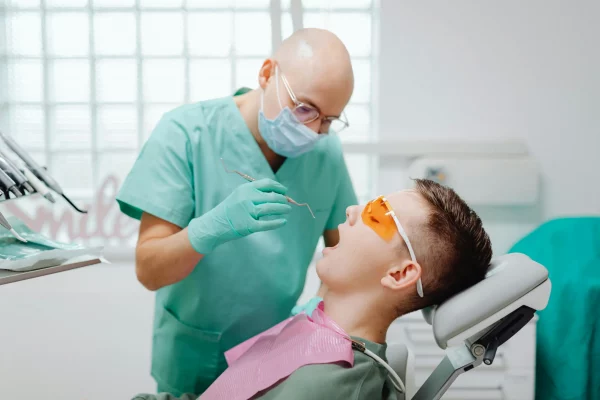Sudden dental pain or oral injury isn’t something to brush off lightly. An Emergency Dental Exam can mean the difference between preserving a tooth and facing much more serious consequences. Ignoring acute symptoms often leads to infections, significant complications, or even irreversible damage. Recognizing when immediate attention is necessary, understanding the appropriate steps to take, and knowing what to anticipate during emergency dental care are all essential. This overview outlines the crucial information needed to make wise choices when urgent dental issues arise.
Signs You Need an Emergency Dental Exam
Oral discomfort and trauma can occur unexpectedly, often disrupting daily activities and causing considerable distress. It is important to recognize, though, that not every dental issue necessitates immediate clinical intervention. Certain symptoms are relatively mild and can be monitored until a routine dental visit, while others serve as critical indicators of underlying, potentially serious concerns.
Distinguishing between these scenarios is essential for minimizing pain, preserving oral health, and avoiding long-term complications. Whether one experiences acute dental pain, a fractured restoration, or injury resulting from sports or accidental impact, the ability to identify symptoms that require urgent professional assessment is paramount.
Severe Tooth Pain or Sensitivity
If you’re experiencing persistent, sharp pain or sudden sensitivity, especially the kind that keeps you up at night or disrupts your routine, you’re probably facing an issue that’s more serious than a basic cavity. These symptoms can point to advanced tooth decay, nerve involvement, or even a dental abscess. Leaving these problems untreated isn’t just risky; it can actually allow infection to spread beyond your mouth and lead to broader health complications. Pain, in this context, is the body’s urgent signal that intervention is needed. It’s unwise to ignore such warnings; prompt dental evaluation is essential to prevent further harm.
Swelling in the Gums or Face
Swelling in the gums, jaw, or cheeks often signals a potentially severe infection, such as a dental abscess. This is not a trivial matter such infections can escalate quickly and become life-threatening if they spread beyond the oral cavity. Common indicators include a persistent unpleasant taste in the mouth, elevated body temperature, or difficulty swallowing. The presence of facial swelling accompanied by pain should prompt immediate consultation with a dental professional. Timely intervention is essential to prevent further complications and protect overall health.
Loose or Knocked-Out Teeth
Accidents happen, whether it’s during sports, a fall, or biting something hard. A loose or knocked-out tooth is a dental emergency that requires immediate attention. The sooner you’re seen ideally within 30 minutes, the better the chances of saving the tooth. Place the tooth in milk or a saline solution and bring it with you to the clinic. Don’t let panic take over; knowing what to do can make all the difference.
What Happens During an Emergency Dental Visit
Understanding what to expect during an emergency dental exam can help reduce anxiety and empower you to act quickly when it matters most. Emergency dental exam can be stressful, but knowing the process ahead of time makes everything feel more manageable. When you arrive at the dental office, the team will prioritize your case based on the urgency of your condition. Whether you’re dealing with intense pain, swelling, bleeding, or a broken tooth, the first goal is to relieve discomfort and stabilize the situation.
Diagnostic Imaging and Oral Examination
Upon arrival, the patient undergoes an initial comprehensive clinical assessment. Typically, the dental practitioner employs digital radiographs or advanced 3D imaging technologies to obtain detailed internal visuals, allowing for accurate identification of the underlying issue whether it’s an abscess, a fracture, or carious lesions. This imaging process is followed by a targeted oral examination, with particular attention given to the symptomatic regions. The dentist evaluates for indicators of infection, trauma, or tissue compromise during this phase.
Immediate Pain Relief and Treatment Options
Once the underlying issue has been identified, the primary objective becomes alleviating the patient’s pain. This may require procedures such as draining an abscess, prescribing antibiotics, or, in more severe cases, administering a nerve block. The approach to pain management is determined by both the origin and intensity of the problem. Occasionally, an interim measure is implemented initially, with definitive treatment planned for a later stage. The overarching aim is to stabilize the patient’s condition and minimize the risk of further complications.
Common Procedures Done in Emergencies
Emergency dental interventions can take several forms, largely determined by the specific issue and its severity. For instance, when a tooth presents with significant infection or decay, root canal treatment is often indicated to eradicate the infection and preserve the tooth structure. Conversely, when a tooth is deemed non-restorable, extraction becomes necessary to prevent further complications. Dental abscesses typically require drainage procedures to alleviate pressure and address the underlying infection. In cases involving fractured or chipped teeth, temporary or permanent restorative materials might be applied to reestablish both function and aesthetics.
Should trauma result in tooth mobility, the application of a splint can promote stability and facilitate healing of the surrounding tissues. While many of these procedures may be completed within a single clinical appointment, complex cases often necessitate additional follow-up visits to ensure comprehensive recovery.
How to Prepare for a Dental Emergency

Dental emergencies rarely announce their arrival in advance. Unexpected incidents such as a tooth fracturing during a meal, a sudden onset of pain late at night, or trauma resulting in a lost tooth during athletic activity can cause considerable distress. In these critical moments, emotional responses like panic are common; nonetheless, preparation remains essential. Having a clear understanding of the appropriate steps to take, relevant contact information, and basic first-aid measures can significantly influence both the stress experienced and the clinical outcome. Proactive knowledge functions as a form of oral first-aid, providing individuals with practical strategies to minimize complications and safeguard dental health until professional care becomes available.
First Aid Tips Before Seeing a Dentist
If you’re dealing with a dental emergency, don’t panic—responding promptly can really make a difference. Before you manage to see a dentist, there are a few essential first aid measures you should consider. Taking the right steps early on can help minimize pain and prevent further complications.
- Gently rinse the mouth with warm water to cleanse the affected area.
- Apply a cold compress externally to minimize swelling.
- If there is bleeding, place sterile gauze or a clean cloth on the site and maintain gentle pressure until the bleeding subsides.
- In cases of an avulsed (knocked-out) tooth, preserve the tooth by keeping it moist—ideally in milk or saline solution.
- It is advisable to avoid aspirin, as it may exacerbate bleeding; acetaminophen is a preferable alternative for pain relief.
Prompt and composed intervention can mitigate further injury and help maintain oral integrity until a dental professional is available.
What to Bring to Your Emergency Exam
If you are ready for a dental emergency, it can help you relax and lower your treatment time. These are the things you should bring to have a smooth trip:
- A passport is a valid ID.
- Insurance card (only when needed)
- List of all current medication being used
- If the records or X-rays exist
- If a tooth or a tooth fragment is missing go ahead and have it ready for treatment.
The presence of these items in the office helps your dental staff to react fast and handle things efficiently.
How Much Does an Emergency Exam Cost?
The cost associated with emergency dental care can fluctuate considerably, contingent upon the specific nature of the dental issue and the interventions required. For a basic emergency assessment, wherein the dentist conducts an examination, performs a diagnostic X-ray, and provides an initial diagnosis, patients should generally anticipate expenses ranging from approximately $75 to $150. Should the clinical situation demand more comprehensive procedures, such as a tooth extraction or root canal therapy, the overall cost is likely to increase substantially, potentially by several hundred dollars. Furthermore, it is noteworthy that seeking dental attention outside of standard office hours (including evenings, weekends, or holidays) often incurs additional surcharges, reflecting both the urgency and the convenience of after-hours care.
Does Insurance Cover Emergency Dental Visits?
Dental insurance coverage for emergencies is, admittedly, inconsistent. Ordinarily, most plans will cover emergency evaluations and the resulting treatments, provided the situation qualifies as “medically necessary”—though, frankly, the determination of necessity can be unpredictable at times. The specifics of coverage vary significantly among different policies; some are notably comprehensive, while others offer only minimal support.
Prudent individuals should consult their insurance provider prior to seeking treatment, rather than attempting to decipher their benefits during an urgent situation. This proactive approach can help prevent unwelcome financial surprises. Additionally, in cases involving injury or trauma, primary health insurance may occasionally contribute to the costs. Ultimately, understanding the extent of one’s coverage beforehand is essential to minimizing additional stress during an already challenging circumstance.
Affordable Emergency Exam Options
Lacking dental insurance doesn’t mean you’re without recourse. Many dental clinics recognize that unexpected dental issues can cause financial hardship, so they typically provide payment plans or financing options, allowing patients to manage expenses over time. For example, GPD Dental offers flexible payment arrangements and accepts a broad range of insurance plans to enhance accessibility. Additionally, certain clinics extend in-house discount programs or sliding-scale fees based on income. It’s crucial not to postpone necessary care due to cost worries; delaying treatment often results in more complicated and expensive dental problems in the future.
Finding Emergency Dental Services Near Me
When faced with an acute dental emergency, time is of the essence. Immediate access to professional care can significantly expedite pain relief and, in many cases, prevent lasting damage to oral structures. Conditions such as avulsed teeth, pronounced orofacial swelling, or intense tooth pain require timely intervention; these are not issues that resolve independently. Establishing a relationship with a reputable emergency dental practitioner is not merely advisable, it may ultimately preserve both dental function and appearance, safeguarding one’s long-term oral health.
What to Look for in an Emergency Dentist
When seeking an emergency dentist, prioritizing a provider with substantial experience in urgent dental care is essential. Access to advanced diagnostic technology, such as digital X-rays and 3D imaging, further ensures that accurate and prompt assessments can be made, facilitating effective treatment planning. Clinics offering same-day or walk-in appointments are particularly valuable, as they provide timely care during acute situations. The availability of sedation or modern pain management techniques is also important, especially for patients experiencing considerable pain or anxiety.
A comprehensive dental office—capable of providing a full spectrum of services, including extractions, root canals, restorative procedures, and cosmetic treatments—eliminates the need to consult multiple providers, streamlining care during stressful emergencies. Additionally, factors such as positive patient feedback, flexible hours (including evenings and weekends), and convenient location should be considered, as these elements can significantly impact the overall patient experience. Ultimately, the ideal emergency dental provider combines clinical expertise with a reassuring, patient-centered approach, fostering a sense of confidence and comfort throughout the treatment process.
24/7 Dental Clinics and Walk-In Availability
Dental emergencies are notably unpredictable and often occur outside standard business hours—late at night, weekends, or during holidays—precisely when most dental practices are unavailable. The unpredictability of such incidents underscores the importance of clinics that offer extended or even round-the-clock emergency services. Walk-in options are especially critical in cases involving acute pain, significant swelling, or dental trauma, as these situations demand immediate intervention.
At GPD Dental in Gaithersburg, the urgency of dental emergencies is fully recognized. To address this need, the clinic provides flexible scheduling, including same-day appointments and comprehensive emergency care. The experienced dental team is committed to restoring patient comfort and safeguarding oral health, regardless of when the emergency arises.
Frequently Asked Questions (FAQs)
1. What qualifies as a dental emergency?
A dental emergency refers to any acute situation involving significant pain, persistent bleeding, noticeable swelling, or trauma that could compromise the health of your teeth or gums. Common examples include avulsed (knocked-out) teeth, dental abscesses, fractures exposing the dental pulp, and bleeding that cannot be controlled through standard measures. If the issue affects essential functions such as eating, speaking, or sleeping, it warrants prompt professional evaluation and intervention.
2. Can I go to the ER for a dental emergency?
Certainly, but only in specific circumstances. The emergency room can administer pain management or prescribe antibiotics if there’s a significant infection, but generally, dental specialists aren’t available there. If you’re experiencing severe facial swelling that threatens your airway or indicates a widespread infection, then the ER is absolutely the right place to go. For dental issues like fractured teeth or lost fillings, though, seeking care from an emergency dental clinic is much more appropriate.
3. How fast can I get an emergency dental appointment?
Many dental clinics intentionally allocate specific appointment times for emergency cases, ensuring swift access for individuals experiencing acute dental issues. Some practices maintain dedicated periods within their daily schedules to accommodate urgent needs, such as severe pain or dental trauma. If you are experiencing significant symptoms, it is advisable to contact the clinic directly and provide a clear description of your condition. Facilities like GPD Dental prioritize emergency calls and endeavor to see patients in distress as promptly as possible.
4. Are emergency dental services more expensive?
Emergency dental procedures typically incur higher costs, particularly when sought outside of standard office hours, such as during nights or weekends. Still, postponing necessary treatment can lead to far more serious—and expensive—complications, including severe infections or permanent tooth loss. Many dental clinics recognize these challenges and offer various financial assistance options or payment plans to help patients access emergency care when needed.
Your Next Step: Don’t delay—get relief now. Dental emergencies can strike without warning, but your response can shape the outcome. Whether it’s an intense toothache, unexpected swelling, or a knocked-out tooth, don’t put off seeking care. GPD Dental is ready to provide fast, effective treatment with compassion and professionalism. We offer flexible scheduling, advanced diagnostics, and personalized treatment plans, all under one roof. Call us today or walk in for your Emergency Dental Exam—we’re here to help when it matters most.


